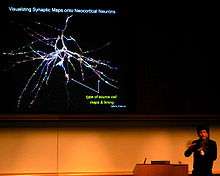Henry Markram
| Henry Markram | |
|---|---|
 Visualizing Synaptic Maps onto Neocortical Neurons | |
| Born |
28 March 1962 South Africa |
| Nationality | Israel |
| Alma mater |
|
| Known for |
Blue Brain Project Human Brain Project Spike-timing-dependent plasticity |
| Awards | Fulbright Scholar |
| Scientific career | |
| Fields | Neuroscience |
| Institutions | École Polytechnique Fédérale de Lausanne |
| Thesis | Acetylcholine interacts with the NMDA receptor through the phosphoinositide pathway (1991) |
| Doctoral advisor | Menahem Segal |
| Website |
people |
Henry John Markram (born 28 March 1962[1]) is a Professor at the École Polytechnique Fédérale de Lausanne (EPFL) in Switzerland and director of the Blue Brain Project and founder of the Human Brain Project.
Education
Henry Markram obtained his Bachelor of Science degree in Physiology and the History and Philosophy of Science from the University of Cape Town, South Africa and his PhD in Neurobiology from the Weizmann Institute of Science, Israel in 1991, under the supervision of Menahem Segal.[1] During his PhD work, he discovered a link between acetylcholine and memory mechanisms by showing that acetylcholine modulates the primary receptor linked to synaptic plasticity.[2]
Personal life
Born in South Africa, Markram is now an Israeli citizen. Markram met his current wife, fellow neuroscientist Kamila Markram (b. 1975), at the Max Planck Institute for Brain Research in Frankfurt.[3] They moved to the École polytechnique fédérale de Lausanne together and, in 2007, founded Frontiers Media.[3] Markram has been married twice and has a total of five children, one of whom, Kai, has autism.[4]
Research
Following his PhD, Markram went to the United States as a Fulbright Scholar at the National Institutes of Health (NIH), where he studied ion channels on synaptic terminals with Elise F. Stanley. As a Minerva Fellow he then went to the Laboratory of Bert Sakmann at the Max Planck Institute, Heidelberg, Germany, where he discovered calcium transients in dendrites evoked by sub-threshold activity, and by single action potentials propagating back into dendrites. He also began studying the connectivity between neurons, describing in great detail how layer 5 pyramidal neurons are interconnected.
Some of his work altered the relative timing of single pre- and post-synaptic action potentials to reveal a learning mechanism operating between neurons where the relative timing in the millisecond range affects the coupling strength between neurons. The importance of such timing has been reproduced in many brain regions and is known as spike timing-dependent synaptic plasticity (STDP).[5]
Markram was appointed assistant professor at the Weizmann Institute of Science, where he started systematically dissecting out the neocortical column. He discovered that synaptic learning can also involve a change in synaptic dynamics (called redistribution of synaptic efficacy) rather than merely changing the strengths of connections. He also studied principles governing neocortical microcircuit structure, function, and emergent dynamics. Together with Wolfgang Maass[6] he developed the so-called theory of liquid state machine, or high entropy computing.
In 2002, he moved to EPFL as full professor and founder/director of the Brain Mind Institute and Director of the Center for Neuroscience and Technology. At the BMI, in the Laboratory for Neural Microcircuitry, Markram continues to study the organisation of the neocortical column, develops tools to carry out multi-neuron patch clamp recordings combined with laser and electrical stimulation as well as multi-site electrical recording, chemical imaging and gene expression.[5]
In 2013, the European Union funded the Human Brain Project, led by Markram, to the tune of $1.3 billion. Markram claimed that the project would create a simulation of the entire human brain on a supercomputer within a decade, revolutionising the treatment of Alzheimer's disease and other brain disorders. Less than two years into it, the project was recognised to be mismanaged and its claims overblown, and Markram was asked to step down.[7][8]
On 8 October 2015, the Blue Brain Project published the first digital reconstruction and simulation of the micro-circuitry of a neonatal rat somatosensory cortex.[9]
References
- 1 2 Henry Markram Curriculum Vitae
- ↑ Markram, H.; Segal, M. (1990). "Electrophysiological characteristics of cholinergic and non-cholinergic neurons in the rat medial septum-diagonal band complex". Brain Research. 513 (1): 171–174. doi:10.1016/0006-8993(90)91106-Q. PMID 2350680.
- 1 2 (in French) Philippe Le Bé, "« Avec Frontiers, les travaux des chercheurs sont publiés rapidement et de manière équitable »", Le Temps, published on-line on Sunday 10 April 2016 (page visited on 10 April 2016).
- ↑ Honigsbaum, Mark (15 October 2013). "Human Brain Project: Henry Markram plans to spend €1bn building a perfect model of the human brain". The Guardian. Retrieved 8 January 2018.
- 1 2 Lehrer, Jonah. "Can a thinking, remembering, decision-making, biologically accurate brain be built from a supercomputer?". Seed Magazine. Retrieved August 28, 2012.
- ↑ Maass, W.; Natschläger, T.; Markram, H. (2002). "Real-Time Computing Without Stable States: A New Framework for Neural Computation Based on Perturbations". Neural Computation. 14 (11): 2531–2560. doi:10.1162/089976602760407955. PMID 12433288.
- ↑ Epstein, Robet. "The Empty Brain". Aeon. Retrieved 8 January 2018.
- ↑ Theil, Stefan. "Why the Human Brain Project Went Wrong—and How to Fix It". Scientific American. Retrieved 8 January 2018.
- ↑ Markram, Henry; Muller, Eilif; Ramaswamy, Srikanth; Reimann, Michael W.; Abdellah, Marwan; Sanchez, Carlos Aguado; Ailamaki, Anastasia; Alonso-Nanclares, Lidia; Antille, Nicolas (2015-10-08). "Reconstruction and Simulation of Neocortical Microcircuitry". Cell. 163 (2): 456–492. doi:10.1016/j.cell.2015.09.029. ISSN 0092-8674.
External links
| Wikimedia Commons has media related to Henry Markram. |
- Henry Markram at TED
